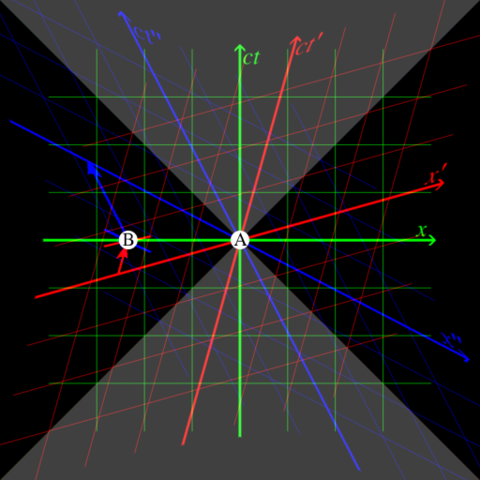Image:Relativity of simultaneity (colour).png
From Wikipedia, the free encyclopedia

Size of this preview: 480 × 480 pixels
Full resolution (512 × 512 pixels, file size: 111 KB, MIME type: image/png)
Summary
| Description |
This picture illustrates the relativity of simultaneity in Lorentz transformations. The three colored reference frames are associated to three different observers in relative motion along the x axis. The y and z axis are perpendicular to the picture and aren't shown. They are identical for the three observers. Relative to the green observer, the red one is traveling at +0.28c and the blue one at approximately −0.52c. Event B is simultaneous with A in the green reference frame, but it occurred before in the blue frame, and will occur later in the red frame. The image becomes clearer once its RGB channels are viewed separately. The upper highlighted area is A's future cone, consisting of the events which will occur after A in any reference frame. The lower highlighted area is A's past cone, consisting of the events which occurred before A in any frame. The interior consists of the events from which a massive particle could have reached A, or which can be reached by a massive particle starting at A. The surface is the light cone: the events which can be reached by a light ray starting at A, or from which a light ray reaching A could have originated. The black areas outside the double cone consist of the events whose temporal ordering with respect to A depends on the frame of reference. |
|---|---|
| Source |
self-made |
| Date |
16 May 2008 |
| Author |
Army1987 ( talk) |
| Permission ( Reusing this image) |
See below. |
Licensing:
|
File history
Click on a date/time to view the file as it appeared at that time.
| Date/Time | Dimensions | User | Comment | |
|---|---|---|---|---|
| current | 14:52, 16 May 2008 | 512×512 (111 KB) | Army1987 ( Talk | contribs) | ({{Information |Description=This picture illustrates the relativity of simultaneity in Lorentz transformations. The three colored reference frames are associated to three different observers in relative motion along the ''x'' axis. The ''y'' and '') |
See the setup instructions for more information.
